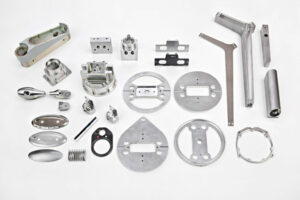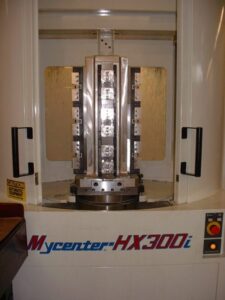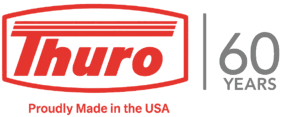CNC Milling
Providing Parts with Tight Tolerances in the Timeframe and Budget You Need… For Over 50 Years
- IS09001-2015 and AS9100 Rev. D certified
- Precise tolerances within ± 0.0002
- Horizontal Milling to (x) 20.1″ (y) 20.1″ and (Z) 16.1″
- Vertical Milling to (x) 40″ x (y)20″ x (z)25″
- State-of-the-art part fixturing, tooling & CAD/CAM software allow for cost-effective & on-time parts
- 15 minute quick changeovers
- Experts in Aluminum, Steel, Alloy Steel, Brass and Stainless Steel
- Full in-house deburring and assembly of gaskets and hardware
- Providing Turn-Key parts and assemblies managing plating, painting, heat treating, screening and marking
- Industries Served: Aircraft, High-end Electronics, Satellite
- Communication, Radar, Defense, Medical, Lighting

Computer numerical control milling (CNC milling) is a precision method for the machining of precision component parts. Typically, the basic geometry of parts, which are fabricated using milling equipment, are rectangular. Using coordinates and codes “post processed” with the aid of Mastercam software, code is generated to provide optimum tool sequences, optimal tool paths and cutting conditions which specifically relates to the relationship between cutter RPM and axis feed rate. In basic terms, a good CAD/CAM package in the hands of an experienced programmer allows them to virtually see the process. Cycle times are established in the design stage and fixturing is designed using CAD/CAM. Our goal is always to present the set-up person with a proven and optimized machining process prior to set-up. This saves valuable time reducing cost while maximizing throughout day one. Thuro takes great care to utilize the full capability of state-of-the-art part fixturing, tooling and CAD/CAM software to precisely and cost-effectively machine complex parts on-time. Our CNC Milling equipment is also programmed and tooled to remove sharp edges and provide burr free precision parts right off the machine.
Horizontal machines lend themselves to greater efficiency as the tombstones are presented to the machine operator while the cutting tools remain behind a servo operated door. Horizontal machines come standard with two tombstones. This allows one tombstone to be in the CNC milling machine “making chips”, while the other tombstone is away from the cutting zone and can be unloaded and loaded. Horizontal milling machines also allow higher feed rates given the simple fact that chips fall away from the surface being cut. Chips get in the way of coolant, slowing down metal removal rates. More than one factor contributes to us.
Applications of CNC Milling
CNC milling is the process of using an electromechanical device designed to control a set of tools along three to five axes. The CAD/CAD software generates coordinates to dictate the movements of the milling machine. The precision of the machines and toolholders themselves allow us to hold tolerances within ± 0.0002”.
Our largest Horizontal milling machines are series H400. H400 machines have a 16” X 16” table size. The working envelope for an H400 machines is as follows: X, Y, and Z axes respectively of 28.9” x 24” x 24”. Our Vertical Milling Centers have the working envelope as follows: 40” x 20” x 25”.
In a milling process the tools rotate and most commonly a solid piece of material in the form of plate, strip or rectangular bar is fixtured to the machine. There are two basic CNC milling machine configurations which are Vertical Milling and Horizontal Milling. In Horizontal Milling, “Tombstones” are the base to which parts are either directly clamped or hold vices, which then are open and closed to hold parts. Horizontal machines lend themselves to greater efficiency as the tombstones are presented to the machine operator while the cutting tools remain behind a servo operated door. Horizontal machines come standard with two tombstones. This allows one tombstone to be in the CNC milling machine “making chips”, while the other tombstone is away from the cutting zone and can be unloaded and loaded. Horizontal milling machines also allow higher feed rates given the simple fact that chips fall away from the surface being cut. Chips get in the way of coolant, slowing down metal removal rates. More than one factor contribute to our ability often achieve, on average, 45 percent higher throughput when using a Horizontal CNC machining center, as opposed to a Vertical CNC machining center.
- IS09001-2015 and AS9100 Rev. D certified
- Precise tolerances within ± 0.0002
- Horizontal Milling to (x) 20.1″ (y) 20.1″ and (Z) 16.1″
- Vertical Milling to (x) 40″ x (y)20″ x (z)25″
- State-of-the-art part fixturing, tooling & CAD/CAM software allow for cost-effective & on-time parts
- 15 minute quick changeovers
- Experts in Aluminum, Steel, Alloy Steel, Brass and Stainless Steel
- Full in-house deburring and assembly of gaskets and hardware
- Providing Turn-Key parts and assemblies managing plating, painting, heat treating, screening and marking
- Industries Served: Aircraft, High-end Electronics, Satellite
- Communication, Radar, Defense, Medical, Lighting
Applications of CNC Milling
Milling that is completed using the CNC milling process changes raw materials by manipulating the surface of a metal, using cutting tools. Some examples of the most common tools used are various types of drills, reamers and multi-flute cutters, such as end mills. Complex parts can be machined with minimal handling due to high-capacity tool magazines, which Horizontal Milling Machines afford. Horizontal machining centers typically come standard with 60 tool stations. Vertical machining centers typically come equipped with 30 tool stations. Thuro equips our horizontal machines with up to 120 tool stations. Not only does this allow for the complete machining of complex parts, machines with large capacity ATC (Automatic tool change) permit.
Benefits of CNC Milling
There are an endless number of benefits for using CNC milling equipment. Modern manufacturing depends on well-planned and efficient operations that can quickly and accurately produce precision, one exactly like the other components. CNC milling centers, with their use of multiple part programs and stocked with a large selection of tooling, are capable of manufacturing parts on demand. Quick change allows for multiple components, used in one high value assembly, to be kitted or machined all in the same work week. This reduces not only WIP, but defects.
Accuracy, as well as scalability, are essential in the production process. Each part of an assembly must meet the standards of the final product. By the most precise, as well as flexible, methods of production, parts match the specifications of the initial design and met delivery requirements.

